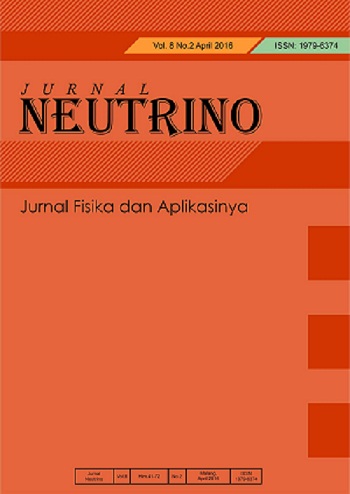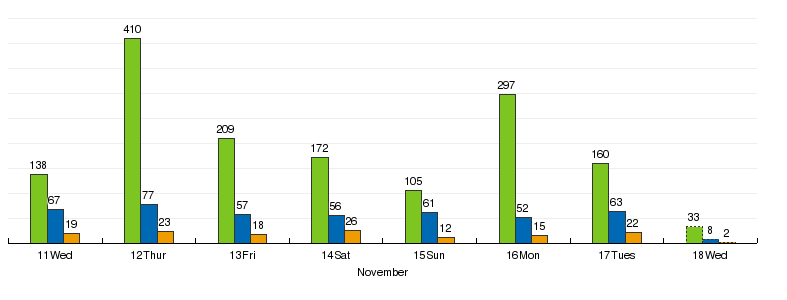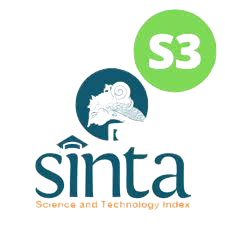CHEMOMETRIC-BASED ELECTRONIC NOSE APPLICATION TO PORK OIL AND OLIVE OIL USING THE ODOR PATTERN CLASSIFICATIONS
Abstract
A chemometric-based electronic nose has designed for analyzing pork oil and olive oil using the odor pattern classifications. The electronic nose (e-nose) built from a combination of several chemical sensors derived from a semiconductor. The data retrieval was done by vaporizing the sample, then being captured by the sensor and identified by the electronic nose (e-nose). The output data from the electronic nose is the voltage released by each sensor. The analyzed samples were 100% olive oil, 100% pork oil and a combination of olive oil and pork oil with a ratio of 50%: 50%. The result of pattern classification using linear discriminant analysis (LDA) method shows that each sample is clustered well with the percentage of first discriminant function value is 87,9% and second discriminant function is 12,1%.
Keywords
Full Text:
PDFReferences
Borràs, E. et al. Olive oil sensory defects classification with data fusion of instrumental techniques and multivariate analysis ( PLS-DA ). Food Chemistry journal. 2016; 203: 314–322.
Che Man, Y.B., Rohman, A. & Mansor, T.S.T. Differentiation of lard from other edible fats and oils by means of Fourier transform infrared spectroscopy and chemometrics. JAOCS, Journal of the American Oil Chemists’ Society. 2011; 88(2): 187–192.
Li, X. et al., A combination of chemometrics methods and GC–MS for the classification of edible vegetable oils. Chemometrics and Intelligent Laboratory Systems. 2016; 155: 145–150.
SH Bintari, K Nugraheni.Decreased Blood Sugar Levels Due to Extra Virgin Olive Oil (Study in the High Fat-Induced Sprague Dawn's Raised Wheat Rat).Jurnal MIPA. 2012; 35 (2):116-121.In Indonesia
Smejkalova, D.; Piccolo, A. High-power gradient diffusion NMR spectroscopy for the rapidassessment of extra-virgin olive oil adulteration. Food Chem. 2010; 118: 153-158.
Gonzalez Martin, Y.; Cerrato Oliveros, M.C.; Perez Pavon, J.L.; Garcia Pinto, C.; Moreno Cordero, B. Electronic nose based on metal oxide semiconductor sensors and pattern recognition techniques: characterisation of vegetable oils. Anal Chim Acta. 2001; 449: 69-80.
Garcia-Gonzalez, D.L.; Aparicio, R. Detection of vinegary defect in virgin olive oils by metal oxide sensors. J. Agric. Food Chem. 2002, 50, 1809-1814.
Garcia-Gonzalez, D.L.; Aparicio, R. Detection of defective virgin olive oils by metal-oxide sensors. Eur Food Res Technol. 2002; 215: 118-123.
Danang Lelono, Muhammad Arifianto Chairiawan. Characterization of Aroma Salak Pondoh Pattern with E-Nose Sensor Metal Oxide Based. IJEIS. 2013 ;3 April 1:71-82.
Scott, S.M., Data Analysis for Electronic Nose Systems, MicrochimActa. 2006; 156: 183-207
Botre, B.A., Gharpure, D.C. & Shaligram, A.D. Sensors and Actuators B : Chemical Embedded Electronic Nose and Supporting Software Tool for its Parameter Optimization. Sensors & Actuators: B. Chemical. 2010; 146(2): 453–459.
J. Trihaas, P.V. Nielsen. Electronic nose technology in quality assessment: mon-itoring the ripening process of Danish blue cheese. J Food Sci. 2005; 70: 44–49.
M. Peris, L.E. Gilabert. A 21st century technique for food control: electronic noses. Anal Chim Acta. 2009; 638: 1–15.
H. Guohua, W. Lvye, M. Yanhong, Z. Lingxia. Study of grass carp (Ctenopharyn-godonidellus) quality predictive model based on the electronic nose. SensActuators B: Chem. 2012; 35: 301–308.
Upadhyay, R., Sehwag, S. & Mishra, H.N. Frying disposal time of sun fl ower oil using hybrid electronic nose- fuzzy logic approach. LWT - Food Science and Technology.2017; 78: 332–339.
Haddi, Z. et al. Discrimination and identification of geographical origin virgin olive oil by an e-nose based on MOS sensors and pattern recognition techniques. Procedia Engineering. 2011; 25:1137–1140.
Nurjuliana, M., Che Man, Y.B. & Mat Hashim, D. Analysis of lard’saroma by an electronic nose for rapid Halal authentication. JAOCS, Journal of the American Oil Chemists’ Society. 2011; 88(1):75–82.
Bagas Surya Wibowo, Imam Tazi, Kuwat Triyana, Pengembangan Sistem Sensor Rasa Berbasis Membran Selektif Ion Untuk Klasifikasi Buah Jeruk. Jurnal Fisika Indonesia. 2013; 49 (XVII): 9-13.
Imam Tazi, Kuwat Triyana, Dwi Siswanta, Anovel Arduino Mega 2560 Microcontroller-Based Electronic Tongue for Dairy Product Classification. AIP Conference Proceedings. 2016; 170003-1 – 170003-5.
Imam Tazi, Anis Choiriyah, Dwi Siswanta, Kuwat Triyana. Detection of Taste Change of Bovine and Goat Milk in Room Ambient using Electronic Tongue. Indones.J.Chem.2017; (3);422-430.
Fraden j. Handbook of Modern Sensors Physics, Designs, And Applications Third Edition.Advanced Monitors Corporation San Diego. California. 2003.
Amalia Berna. Metal Oxide Sensors for Electronic Noses and TheirApplication to Food Analysis. Sensor. 2010; 10: 3882-3910.
DOI: https://doi.org/10.18860/neu.v10i2.4951
Refbacks
- There are currently no refbacks.
Copyright (c) 2018 Imam Tazi, Muthmainnah Muthmainnah, Suyono Suyono, Avin Ainur, Fajrul Falah, Arum Sinda Santika

This work is licensed under a Creative Commons Attribution-NonCommercial-ShareAlike 4.0 International License.
Published By:
Program Studi Fisika Fakultas Sains dan Teknologi Universitas Islam Negeri (UIN) Maulana Malik Ibrahim Malang, Indonesia
B.J. Habibie 2nd Floor
Jl. Gajayana No.50 Malang 65144
Telp./Fax.: (0341) 558933
Email: neutrino@uin-malang.ac.id
This work is licensed under a Creative Commons Attribution-NonCommercial-ShareAlike 4.0 International License
View My Stats










